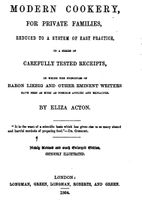No. 2
By Eliza Acton
Published 1845


The centre spaces can be filled, after the jelly is dished, with very light whipped cream, coloured and flavoured so as to eat agreeably with it, and to please the eye as well: this may be tastefully garnished with preserved, or with fresh fruit; but one of more recent invention, called the Belgrave mould (which is to be had of the originators, Messrs. Temple and Reynolds, Princes Street, Cavendish Square, and also at 80, Motcomb Street, Belgrave Square), is of superior construction for the purpose, as it contains a large central cylinder and six smaller ones, which when withdrawn, after the jelly—which should be poured round, but not into them—is set, leave vacancies which can be filled either with jelly of another colour, or with fruit of different kinds (which must be secured in its place with just liquid jelly poured carefully in after it is arranged), or with blanc-mange, or any other isinglass-cream. The space occupied by the larger cylinder may be left empty, or filled, before the jelly is served, with white or with pale-tinted whipped cream. Water, only sufficiently warm to detach the jelly from them without heating or melting it, must be poured into the cylinders to unfix them; and to loosen the whole so as to unmould it easily, a cloth wrung out of very hot water must be wound round it, or the mould must be dipped quickly into some which is nearly or quite boiling. A dish should then be laid on it, it should be carefully reversed, and the mould lifted from it gently. It will sometimes require a slight sharp blow to detach it quite.
Become a Premium Member to access this page
Unlimited, ad-free access to hundreds of the world’s best cookbooks
Over 160,000 recipes with thousands more added every month
Recommended by leading chefs and food writers
Powerful search filters to match your tastes
Create collections and add reviews or private notes to any recipe
Swipe to browse each cookbook from cover-to-cover
Manage your subscription via the My Membership page
Part of
Advertisement
Advertisement


